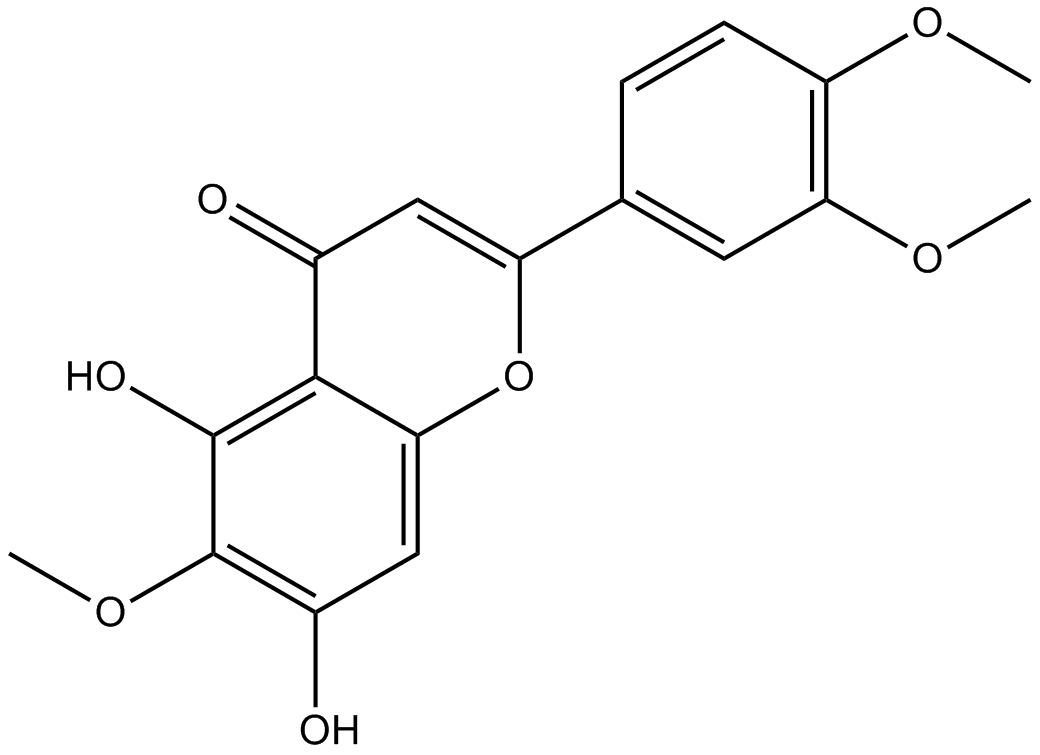Eupatilin (Synonyms: NSC 122413) |
| Catalog No.GN10511 |
Products are for research use only. Not for human use. We do not sell to patients.

Cas No.: 22368-21-4
Sample solution is provided at 25 µL, 10mM.
GlpBio Products Cited In Reputable Papers
Product Documents
Quality Control & SDS
- View current batch:
- Purity: >99.00%
- COA (Certificate Of Analysis)
- SDS (Safety Data Sheet)
- Datasheet
- Purity: >98.00%
- COA (Certificate Of Analysis)
- SDS (Safety Data Sheet)
- Datasheet
- Purity: >98.00%
- COA (Certificate Of Analysis)
- SDS (Safety Data Sheet)
- Datasheet
| Cas No. | 22368-21-4 | SDF | |
| Synonyms | NSC 122413 | ||
| Chemical Name | 2-(3,4-dimethoxyphenyl)-5,7-dihydroxy-6-methoxychromen-4-one | ||
| Canonical SMILES | COC1=C(C=C(C=C1)C2=CC(=O)C3=C(C(=C(C=C3O2)O)OC)O)OC | ||
| Formula | C18H16O7 | M.Wt | 344.32 |
| Solubility | ≥ 34.4mg/mL in DMSO | Storage | Store at -20°C |
| General tips | Please select the appropriate solvent to prepare the stock solution according to the
solubility of the product in different solvents; once the solution is prepared, please store it in
separate packages to avoid product failure caused by repeated freezing and thawing.Storage method
and period of the stock solution: When stored at -80°C, please use it within 6 months; when stored
at -20°C, please use it within 1 month. To increase solubility, heat the tube to 37°C and then oscillate in an ultrasonic bath for some time. |
||
| Shipping Condition | Evaluation sample solution: shipped with blue ice. All other sizes available: with RT, or with Blue Ice upon request. | ||
Complete Stock Solution Preparation Table
| Prepare stock solution | |||

|
1 mg | 5 mg | 10 mg |
| 1 mM | 2.9043 mL | 14.5214 mL | 29.0428 mL |
| 5 mM | 0.5809 mL | 2.9043 mL | 5.8086 mL |
| 10 mM | 0.2904 mL | 1.4521 mL | 2.9043 mL |
In vivo Formulation Calculator (Clear solution)
Step 1: Enter information below (Recommended: An additional animal making an allowance for loss during the experiment)
 g
g
 μL
μL

Step 2: Enter the in vivo formulation (This is only the calculator, not formulation. Please contact us first if there is no in vivo formulation at the solubility Section.)
Calculation results:
Working concentration: mg/ml;
Method for preparing DMSO master liquid: mg drug pre-dissolved in μL DMSO ( Master liquid concentration mg/mL, Please contact us first if the concentration exceeds the DMSO solubility of the batch of drug. )
Method for preparing in vivo formulation: Take μL DMSO master liquid, next addμL PEG300, mix and clarify, next addμL Tween 80, mix and clarify, next add μL ddH2O, mix and clarify.
Method for preparing in vivo formulation: Take μL DMSO master liquid, next add μL Corn oil, mix and clarify.
Note: 1. Please make sure the liquid is clear before adding the next solvent.
2. Be sure to add the solvent(s) in order. You must ensure that the solution obtained, in the previous addition, is a clear solution before proceeding to add the next solvent. Physical methods such as vortex, ultrasound or hot water bath can be used to aid dissolving.
3. All of the above co-solvents are available for purchase on the GlpBio website.
Related Products
- GC14442 TCS 46b
- GC35941 E3 ligase Ligand-Linker Conjugates 35 Hydrochlride
- GC34198 KRas G12C inhibitor 1
- GC48656 N-desethyl Etonitazene
- GC19701 Diclofenac Epolamine
- GC45413 Cridanimod (sodium salt)
- GC40298 N-acetyl-5-Aminosalicylic Acid
- GC37780 Thevetiaflavone
- GC12765 2-4-Quinolinediol
- GC32380 Tauroxicum
- GC46073 4-hydroxy McPT (hydrochloride)
- GC38109 Enfuvirtide acetate
- GC44311 Naftopidil (hydrochloride)
- GC16035 NBD-556
- GC12624 3,4-DAA
- GC41665 (±)8(9)-EET Ethanolamide
Reviews
Average Rating: 5 ★★★★★ (Based on Reviews and 30 reference(s) in Google Scholar.)
GLPBIO products are for RESEARCH USE ONLY. Please make sure your review or question is research based.
Required fields are marked with *


















